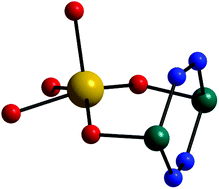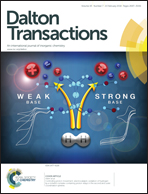Formation of bis(μ-tetrazolato)dinickel(ii) complexes with N,N,O-donor Schiff bases via in situ 1,3-dipolar cyclo-additions: isolation of a novel bi-cyclic trinuclear nickel(ii)–sodium(i)–nickel(ii) complex†
Abstract
A dinuclear and a novel bi-cyclic hetero trinuclear bis(μ-tetrazolato) bridged nickel(II) Schiff base complexes [Ni2(L1)2(PTZ)2] (1) and [Ni2(L2)2(PTZ)2Na(H2O)]ClO4·H2O (2) {where HL1 = 2-((2-(dimethylamino)ethylimino)methyl)-6-methoxyphenol, HL2 = 2-((2-(methylamino)ethylimino)methyl)-6-methoxyphenol and HPTZ = 5-(2-pyridyl)tetrazole} have been synthesized by in situ 1,3-dipolar cyclo-addition and characterized by spectral analysis, X-ray crystallography, and variable-temperature magnetic susceptibility measurements. Both the complexes crystallize in monoclinic space group P21/c. Both the complexes feature double μ-NN′-tetrazolato bridged dinickel(II) structures, in which each nickel(II) is coordinated meridionally by a depronated terdentate Schiff base [(L1)− for 1 and (L2)− for 2] and two nitrogen atoms of the (PTZ)−. A nitrogen atom from a symmetry related bridging (PTZ)− coordinates to complete the distorted octahedral geometry of nickel(II). The phenoxo and methoxo oxygen atoms from two [NiL2] units and a water molecule coordinate to a sodium(I) to form the unique bi-cyclic trinuclear nickel(II)–sodium(I)–nickel(II) core in complex 2. Very strong π⋯π stacking is observed in complex 2 to form a supramolecular chain. The variable-temperature (1.8–300 K) magnetic susceptibility measurements show the presence of anti-ferromagnetic coupling between two nickel(II) centers for both complexes with J = −2.14(1) cm−1 (for 1) and J = −1.20(2) cm−1 (for 2). To obtain a better understanding of the magnetic exchange mechanism, quantum mechanical (DFT) calculations have been performed. The calculated J values [Jtheo = −4.53 cm−1 (for 1) and Jtheo = −2.48 cm−1 (for 2)] are in agreement with the values obtained experimentally.


 Please wait while we load your content...
Please wait while we load your content...